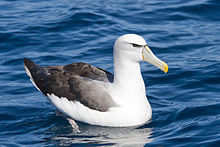Aequornithes
| Aequornithes Temporal range: Late Cretaceous (Possible stem-loons date to this epoch) to present
| |
|---|---|

| |
| Shy albatross (Thalassarche cauta) | |
| Scientific classification | |
| Domain: | Eukaryota |
| Kingdom: | Animalia |
| Phylum: | Chordata |
| Class: | Aves |
| Clade: | Phaethoquornithes |
| Clade: | Aequornithes Mayr, 2010 |
| Clades | |
Aequornithes (from Latin aequor, expanse of water + Greek ornithes, birds), or core water birds[1] are defined as "the least inclusive clade containing Gaviidae and Phalacrocoracidae".[2]
The monophyly of the group is currently supported by several molecular phylogenetic studies.[3][4][5][6]
Aequornithes includes the clades Gaviiformes, Sphenisciformes, Procellariiformes, Ciconiiformes, Suliformes and Pelecaniformes. It does not include several unrelated groups of aquatic birds such as flamingos and grebes (Mirandornithes), shorebirds and auks (Charadriiformes), or the Anseriformes.
Based on a whole-genome analysis of the bird orders, the kagu and sunbittern (Eurypygiformes) and the three species of tropicbirds (Phaethontiformes) together styled as the Eurypygimorphae are the closest sister group of the Aequornithes in the clade Ardeae.[1]
| Aequornithes |
| ||||||||||||||||||||||||||||||||||||||||||||||||||||||
Cladogram based on Burleigh, J.G. et al.(2015)[7]
References
- ^ a b Jarvis, E.D.; et al. (12 December 2014). "Whole-genome analyses resolve early branches in the tree of life of modern birds". Science. 346 (6215): 1320–1331. doi:10.1126/science.1253451.
{{cite journal}}: Explicit use of et al. in:|first1=(help) - ^ Mayr, G. (February 2011). "Metaves, Mirandornithes, Strisores and other novelties – a critical review of the higher-level phylogeny of neornithine birds". J Zool Syst Evol Res. 49 (1): 58–76. doi:10.1111/j.1439-0469.2010.00586.x.
- ^ Hackett, S.J.; et al. (27 June 2008). "A Phylogenomic Study of Birds Reveals Their Evolutionary History". Science. 320 (5884): 1763–1768. doi:10.1126/science.1157704.
{{cite journal}}: Explicit use of et al. in:|first1=(help) - ^ Yuri, T.; et al. (2013). "Parsimony and model-based analyses of indels in avian nuclear genes reveal congruent and incongruent phylogenetic signals". Biology. 2 (1): 419–444. doi:10.3390/biology2010419.
{{cite journal}}: Explicit use of et al. in:|first1=(help)CS1 maint: unflagged free DOI (link) - ^ Kimball, R.T.; et al. (December 2013). "Identifying localized biases in large datasets: A case study using the Avian Tree of Life". Mol Phylogenet Evol. 69 (3): 1021–32. doi:10.1016/j.ympev.2013.05.029.
{{cite journal}}: Explicit use of et al. in:|first1=(help) - ^ Kuramoto, T. et al. (November 2015). "Determining the Position of Storks on the Phylogenetic Tree of Waterbirds by Retroposon Insertion Analysis". Genome Biology and Evolution, 7 (12):3180–3189. doi:10.1093/gbe/evv213 PDF fulltext.
- ^ Burleigh, J.G.; et al. (March 2015). "Building the avian tree of life using a large-scale, sparse supermatrix". Molecular Phylogenetics and Evolution. 84: 53–63. doi:10.1016/j.ympev.2014.12.003.
{{cite journal}}: Explicit use of et al. in:|first1=(help)

